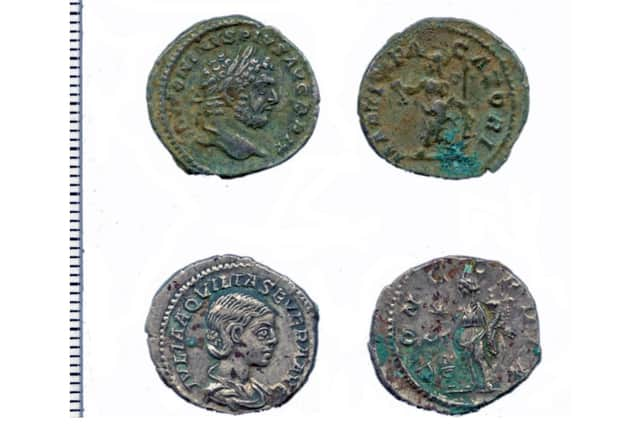Hoard of 1,000 Roman silver coins found near Doncaster is acquired by council
and live on Freeview channel 276
The buried treasure of 1,000 silver pieces provides a rare glimpse of Roman history in the area – and the Norton Hoard, as it has been dubbed is one of the largest found in the region.
The collection spans approximately 192 years of Roman rule in Britain and was discovered by a metal detector user – who wishes to remain anonymous - in Norton five years ago.
Advertisement
Hide AdAdvertisement
Hide AdThe coins were reported as treasure to Amy Downes, the local Finds Liaison Officer of the British Museum’s Portable Antiquities Scheme, in 2018.


Following being declared treasure by South Yorkshire assistant coroner, the hoard; including fragments of the pottery vessel they were buried in, has been purchased by Heritage Doncaster, on behalf of the people of the City of Doncaster.
The purchase was made possible with support from the Arts Council England/V&A Purchase Grant Fund, The Headley Museums Archaeological Acquisitions Fund and the Friends of Doncaster Museums, with match funding from a private bequest to Heritage Doncaster.
The hoard contains coins from 18 Roman Emperors, and in some instances their wives and even mothers.
Advertisement
Hide AdAdvertisement
Hide AdThe earliest coins of Mark Anthony, date back to 32BC, almost two hundred years older than the last coins of Severus Alexander.
Present amongst the hoard are coins of the emperor Nero, famous for ‘fiddling whilst Rome Burned’; Hadrian, architect of the famous wall named after him, which divided Britannia (Roman Britain) from the Barbarian people of Caledonia (Scotland), Commodus, famed for his love of Gladiatorial games and Septimius Severus and his wife Julia Domna; the North African imperial couple who famously set up their imperial residence in York, whilst Severus campaigned in Scotland.
The circumstances surrounding the burial of the hoard, which can be dated to some-time after 231 AD (based on the latest datable coins in the hoard), will forever remain a mystery.
The hoard was found in what would have been a rural, farming landscape in the Roman period, well away from any of the major Roman towns like Doncaster, Castleford or
Advertisement
Hide AdAdvertisement
Hide AdPontefract. The nearest Roman city was York, 28 miles to the north.
The hoard could represent the accumulated wealth of a single individual or of a family or small community. It could have been intended to pay taxes, be an offering to the gods, be
savings from business transactions or even be life savings of one or more people.
All that can be certain is that whoever buried it and for whatever purpose, either they never intended to recover it, or were unable to.
Advertisement
Hide AdAdvertisement
Hide AdMayor of Doncaster, Ros Jones, said: “What an incredible find! This hoard of Roman coins provides a glimpse into the history of Roman Britain from 1,800 years ago.
"It allows us to imagine how such a valuable asset came to be buried in the first place and now this treasure will be a part of Doncaster’s history forever.”
Professor Michael Lewis, Head of Portable Antiquities andTreasure, British Museum stated: “The British Museum is very pleased that this important find has been acquired by Doncaster Museum for public display.
"The Portable Antiquities Scheme is an essential part of the Museum’s work across the country, recording finds made by the public and ensuring those that are treasure are acquired by museums for the public to learn about and enjoy.”
Advertisement
Hide AdAdvertisement
Hide AdPeter Robinson, Collections and Exhibitions Officer (Archaeology) at Heritage Doncaster, added: “It is thanks to metal detector users and other members of the public, dedicated toresearching and going out searching for our shared past, and reporting their finds to the Portable Antiquities Scheme, that such wonderful and important finds come to light. We’re
delighted that we’ve been able to acquire this treasure so that everyone can enjoy and learn from their heritage.”
Much more of Doncaster’s Roman History, and more besides, can be seen at the Danum Gallery, Library and Museum, which is free entry.
Opening times and further visitor information can be found at https://www.dglam.org.uk/visit/
Advertisement
Hide AdAdvertisement
Hide AdPeter Robinson will be giving a talk on the Norton Hoard on Saturday 13 May at 11am at the Danum Gallery, Library and Museum. Tickets are £5 per person, limited places are
available. To book tickets visit www.dglam.org.uk/nortonhoard